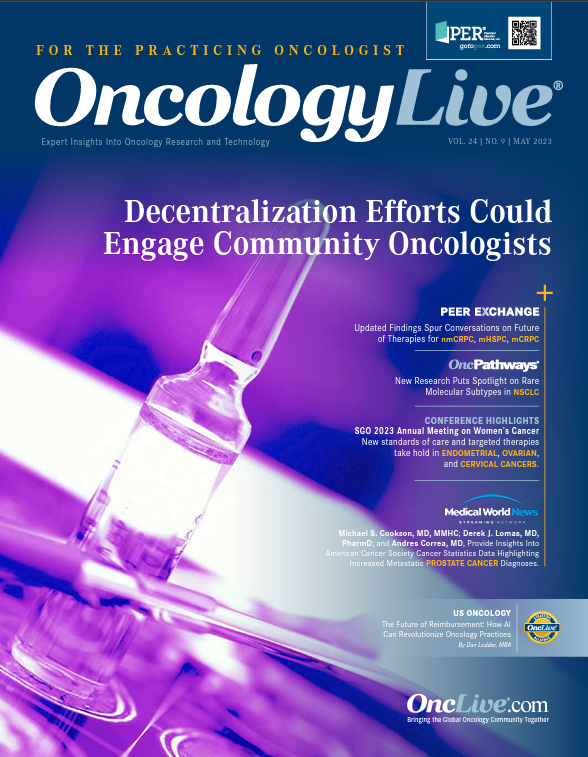Publication
Article
Oncology Live®
Oncologists Prepare to Bridge Knowledge Gap on Clinical Trial Outcomes With Patients
Author(s):
When patients with cancer are asked to be participants in a clinical trial, they are informed that a primary purpose of the investigative effort is to develop objectively valid, generalizable information that may be of value to patients with the same malignancy or benefit researchers in the development of future studies.
Maurie Markman, MD

When patients with cancer are asked to be participants in a clinical trial, they are informed that a primary purpose of the investigative effort is to develop objectively valid, generalizable information that may be of value to patients with the same malignancy or benefit researchers in the development of future studies. A critical end product of all clinical investigation is formal peer-reviewed publication of the study results. Prior to this event, data can be publicly presented in a variety of formats at scientific meetings.
A core component of valid clinical research is the appropriate use of well-established statistical tools in the specific type of investigative effort being undertaken. For example, in therapeutic cancer research involving human participants, clinical trials are generally considered to fall within several relatively discrete categories.
Phase 1 antineoplastic agent studies usually involve a limited number of patients and are primarily designed to examine the safety, pharmacokinetics, and optimal methods of drug delivery to be explored in future studies. Phase 2 trials employing an administration schedule found to be acceptably safe in preceding phase 1 studies generally involve a larger patient sample with the major goal to determine the degree of efficacy in a defined patient population (eg, platinum-resistant ovarian cancer). Finally, in a phase 3 trial, 2 or more antineoplastic regimens are directly compared in a randomized study with several possible primary end points, which may include objective response rate (ORR), time to subsequent disease progression, and/or overall survival.
The primary objectives of these study phases are not the only end points prospectively evaluated. For example, although determining the ORR or time to disease progression may not be the major goal of a phase 1 study, patients and the entire participant population will be analyzed for the effect of therapy on these outcomes, with the results often informally compared with a variety of historical groups with similar clinical characteristics. Additionally, in phase 2 and phase 3 studies, additional data will be generated regarding the toxicity profile of the experimental regimen, which includes longer-term follow-up beyond that reported in the initial phase 1 trials.
Regardless of how researchers may personally view study outcomes, particularly in the earlier phase 1 or nonrandomized phase efforts, the established clinical investigative rules of a given study format define the appropriate nature of the conclusions permitted in each phase. Thus, an investigative team can certainly describe the fact that an observed ORR in a single-arm phase 2 study was approximately double what might have been expected based on historical data—referencing their own or previously published data—in a particular setting. However, standard clinical scientific rules do not permit them to declare such superiority in the absence of randomized phase 3 (or possibly randomized phase 2) study data, which reveal and confirm clinical outcomes.
The preceding discussion is the stuff of textbooks. It is objectively impossible to disagree with the statement that the development of scientifically rigorous paradigms for the prospective design and statistical analysis of clinical cancer studies has played a crucial role in the establishment of today’s evidence-based approaches to disease management. However, it is also important to note that until recently, the principal audience for study results has been the research community and related health-regulatory organizations. But that was the past, not the present, and certainly not the future.
Moving Scientific Findings into the Public Eye
Today, promising study results from a phase 2 or even some phase 1 trials are widely reported in various media and can be found through a simple search on the internet. So if patients with cancer who are refractory to standard-of-care therapies learn that a study conducted at several nationally recognized cancer institutions has just been reported to produce a response rate more than double that expected based on historical controls in their specific clinical setting, what do you expect the response of the patient or caregiver to be? It would be fair to infer that they would want to know whether they are a candidate for such a treatment.
The question being posed here is far from hypothetical. Consider the following: A woman aged 62 years has just received a diagnosis of stage III rectal adenocarcinoma. Standard treatment includes chemoradiotherapy and surgery, but the patient’s brother has just read a news story that investigators have reported the results of a small phase 2 study of singleagent checkpoint inhibitor therapy as a neoadjuvant approach in individuals with molecular evidence of mismatch repair deficiency.1 All treated patients (n = 12) in this small trial achieved a clinical complete response defined as no evidence of tumor on MRI, positron emission tomography scan, endoscopic evaluation, digital rectal examination, or biopsy.1
At the time of the study report, there was no evidence of recurrent or locally progressive disease with a follow-up of 6 to 25 months. Further, no grade 3 or greater toxicities were reported. At the time of this published report, 4 of the treated individuals had a sustained clinical complete response at least 1 year after study completion. Finally, no patient had required receipt of either chemoradiotherapy or surgery.1
The study conclusions were, per protocol, conservative. A comment was made that “mismatch repair–deficient, locally advanced rectal cancer was highly sensitive to single-agent PD-1 blockade.” Authors also added an appropriate caveat related to the relatively short duration of follow-up. It was further noted in the manuscript text, “Although the results of our study are promising, especially given that 12 consecutive patients all had a clinical complete response, the study is small and represents the experience of a single institution.”1
Finally, and to the major point of this commentary, the investigators wrote, “These findings must be reproduced in a larger prospective cohort that balances academic and community practices and ensures the participation of patients from a diverse set of racial and ethnic backgrounds.”1 Of course, there is nothing wrong with these statements, which represent a perfectly reasonable clinical academic response to the results of a small study, regardless of the striking outcomes observed.
However, the responses in the discussion portion of the academic article do not address the question being asked by the patient and her family. She may want to know how to determine whether her tumor has evidence of mismatch repair deficiency. Further, if it does, and assuming she has been appropriately provided with information regarding the limitations of the existing data (eg, relatively small sample size and modest, short-term follow-up), is there any legitimate reason why she cannot be treated as described in the New England Journal of Medicine manuscript? As the great baseball philosopher Yogi Berra is reported to have noted, “The future ain’t what it used to be,” and clinicians need to be prepared to address questions such as these.










